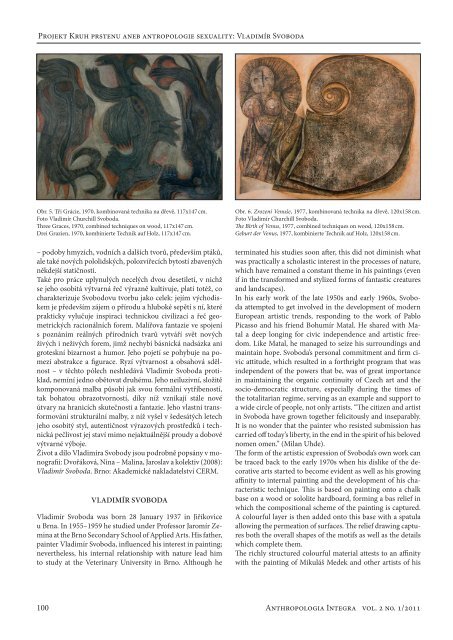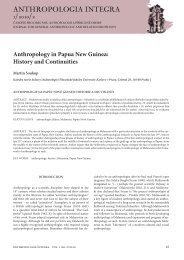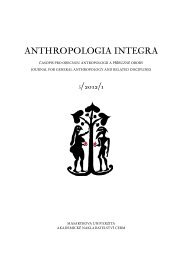ANTHROPOLOGIA INTEGRA 2/2011/1 - Ústav antropologie
ANTHROPOLOGIA INTEGRA 2/2011/1 - Ústav antropologie
ANTHROPOLOGIA INTEGRA 2/2011/1 - Ústav antropologie
Create successful ePaper yourself
Turn your PDF publications into a flip-book with our unique Google optimized e-Paper software.
Projekt Kruh prstenu aneb <strong>antropologie</strong> sexuality: Vladimír Svoboda<br />
Obr. 5. Tři Grácie, 1970, kombinovaná technika na dřevě, 117x147 cm.<br />
Foto Vladimír Churchill Svoboda.<br />
Three Graces, 1970, combined techniques on wood, 117x147 cm.<br />
Drei Grazien, 1970, kombinierte Technik auf Holz, 117x147 cm.<br />
– podoby hmyzích, vodních a dalších tvorů, především ptáků,<br />
ale také nových pololidských, polozvířecích bytostí zbavených<br />
někdejší statičnosti.<br />
Také pro práce uplynulých necelých dvou desetiletí, v nichž<br />
se jeho osobitá výtvarná řeč výrazně kultivuje, platí totéž, co<br />
charakterizuje Svobodovu tvorbu jako celek: jejím východiskem<br />
je především zájem o přírodu a hluboké sepětí s ní, které<br />
prakticky vylučuje inspiraci technickou civilizací a řeč geometrických<br />
racionálních forem. Malířova fantazie ve spojení<br />
s poznáním reálných přírodních tvarů vytváří svět nových<br />
živých i neživých forem, jimž nechybí básnická nadsázka ani<br />
groteskní bizarnost a humor. Jeho pojetí se pohybuje na pomezí<br />
abstrakce a figurace. Ryzí výtvarnost a obsahová sdělnost<br />
– v těchto pólech neshledává Vladimír Svoboda protiklad,<br />
nemíní jedno obětovat druhému. Jeho neiluzivní, složitě<br />
komponovaná malba působí jak svou formální vytříbeností,<br />
tak bohatou obrazotvorností, díky níž vznikají stále nové<br />
útvary na hranicích skutečnosti a fantazie. Jeho vlastní transformování<br />
strukturální malby, z níž vyšel v šedesátých letech<br />
jeho osobitý styl, autentičnost výrazových prostředků i technická<br />
pečlivost jej staví mimo nejaktuálnější proudy a dobové<br />
výtvarné výboje.<br />
Život a dílo Vladimíra Svobody jsou podrobně popsány v monografii:<br />
Dvořáková, Nina – Malina, Jaroslav a kolektiv (2008):<br />
Vladimír Svoboda. Brno: Akademické nakladatelství CERM.<br />
Vladimír Svoboda<br />
Vladimír Svoboda was born 28 January 1937 in Jiříkovice<br />
u Brna. In 1955–1959 he studied under Professor Jaromír Zemina<br />
at the Brno Secondary School of Applied Arts. His father,<br />
painter Vladimír Svoboda, influenced his interest in painting;<br />
nevertheless, his internal relationship with nature lead him<br />
to study at the Veterinary University in Brno. Although he<br />
Obr. 6. Zrození Venuše, 1977, kombinovaná technika na dřevě, 120x158 cm.<br />
Foto Vladimír Churchill Svoboda.<br />
The Birth of Venus, 1977, combined techniques on wood, 120x158 cm.<br />
Geburt der Venus, 1977, kombinierte Technik auf Holz, 120x158 cm.<br />
terminated his studies soon after, this did not diminish what<br />
was practically a scholastic interest in the processes of nature,<br />
which have remained a constant theme in his paintings (even<br />
if in the transformed and stylized forms of fantastic creatures<br />
and landscapes).<br />
In his early work of the late 1950s and early 1960s, Svoboda<br />
attempted to get involved in the development of modern<br />
European artistic trends, responding to the work of Pablo<br />
Picasso and his friend Bohumír Matal. He shared with Matal<br />
a deep longing for civic independence and artistic freedom.<br />
Like Matal, he managed to seize his surroundings and<br />
maintain hope. Svoboda’s personal commitment and firm civic<br />
attitude, which resulted in a forthright program that was<br />
independent of the powers that be, was of great importance<br />
in maintaining the organic continuity of Czech art and the<br />
socio-democratic structure, especially during the times of<br />
the totalitarian regime, serving as an example and support to<br />
a wide circle of people, not only artists. “The citizen and artist<br />
in Svoboda have grown together felicitously and inseparably.<br />
It is no wonder that the painter who resisted submission has<br />
carried off today’s liberty, in the end in the spirit of his beloved<br />
nomen omen.” (Milan Uhde).<br />
The form of the artistic expression of Svoboda’s own work can<br />
be traced back to the early 1970s when his dislike of the decorative<br />
arts started to become evident as well as his growing<br />
affinity to internal painting and the development of his characteristic<br />
technique. This is based on painting onto a chalk<br />
base on a wood or sololite hardboard, forming a bas relief in<br />
which the compositional scheme of the painting is captured.<br />
A colourful layer is then added onto this base with a spatula<br />
allowing the permeation of surfaces. The relief drawing captures<br />
both the overall shapes of the motifs as well as the details<br />
which complete them.<br />
The richly structured colourful material attests to an affinity<br />
with the painting of Mikuláš Medek and other artists of his<br />
100<br />
Anthropologia Integra vol. 2 no. 1/<strong>2011</strong>




